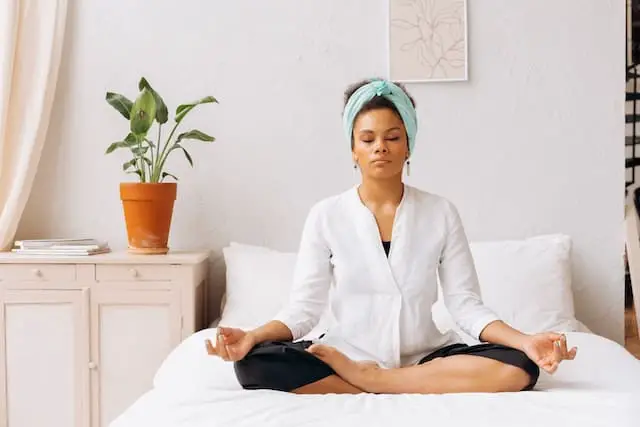How to meditate in bed – Do you struggle to find the time or energy to meditate? Maybe you’re a busy person with a hectic schedule, or perhaps you simply prefer the comfort of your own bed. Whatever your reason may be, know that it’s possible to meditate in bed and still reap all the benefits of this calming practice.
Meditating in bed can help you start your day off on the right foot or unwind before going to sleep. It’s also an excellent way to incorporate mindfulness into your daily routine without having to carve out extra time.
In this article, we’ll guide you through creating a peaceful atmosphere in your bedroom, choosing a comfortable meditation position, and practicing mindfulness meditation so that you can achieve a deep sense of relaxation from the comfort of your own bed.
How to Meditate in Bed

Create a Peaceful Atmosphere in Your Bedroom
If you want to relax before sleep, it’s important to create a peaceful atmosphere in your bedroom for the inner peace meditation. Start by decluttering your space and keeping it organized. Use calming colors like blue or green for your bedding and walls. Add some soft lighting, such as candles or dimmed lamps, to create a serene ambiance.
Next, bring nature into your bedroom by adding plants or flowers. They not only look beautiful but also purify the air and promote relaxation. Keep the temperature comfortable by adjusting your thermostat or using a fan if necessary. Make sure that you have enough pillows and blankets to keep you cozy throughout the meditation practice.
Lastly, remove any distractions from your bedroom like TV or other electronic devices that may interfere with your meditation practice. If you need music to help you meditate, choose something soothing and instrumental instead of upbeat songs with lyrics.
Creating a peaceful environment is crucial for effective meditation practice in bed; it will prepare both mind and body for deep relaxation so that you can fall asleep easily afterward.
As you finish creating a peaceful atmosphere in your bedroom, it’s time to choose a comfortable meditation position.
Choose a Comfortable Meditation Position
Find a comfortable position that allows you to relax and release tension so that you can fully focus on your breath and the present moment. There are several meditation positions that you can try while lying in bed, such as lying flat on your back with arms by your side or placing a pillow beneath your knees for added support. You may also want to try lying on your side with a pillow between your legs or sitting up straight against the headboard with crossed legs.
Here is a table of different meditation positions you can try:
| Position | Description |
|---|---|
| Lying flat on back | Arms by side, palms facing up |
| Pillow under knees | Allows for lower back support |
| Side-lying | Pillow between legs for added comfort |
| Sitting up against headboard | Crossed legs or feet flat on the bed |
Remember, it’s important to find what works best for you. Experiment with different positions until you find one that feels most comfortable and supportive.
Once you’ve found a comfortable position, take time to settle into it before beginning your meditation practice. There are many simple meditation techniques you can try. Take a few deep breaths, scan through your body for any areas of tension, and consciously release them. Then, bring awareness to your breath and begin focusing on its rhythm and flow. With regular practice, meditating in bed can become an essential part of winding down at night and setting intentions for the day ahead during morning routines.
Practice Mindfulness Meditation

Practice mindfulness by bringing awareness to the present moment and focusing on the rhythm and flow of your breath, making it an essential part of your daily routine.
While lying in bed, close your eyes and let yourself sink into the mattress. Take a deep breath in through your nose, hold it for a few seconds, then exhale slowly through your mouth.
As you breathe deeply, pay attention to how your body feels. Notice any areas of tension or discomfort and try to release them with each exhalation.
If your mind starts to wander, gently bring it back to the sensation of breathing. You don’t need to clear your mind completely; simply observe any thoughts or feelings that arise without judgment.
Practicing mindfulness meditation before sleep can help calm racing thoughts and promote relaxation. By developing this habit, you may find that falling asleep becomes easier and more restful.
With consistent practice, you can make meditation a natural part of winding down at night and create a peaceful atmosphere for restful slumber.
Frequently Asked Questions
Can I meditate in bed if I have trouble falling asleep?
If you have trouble falling asleep, it’s natural to want to find a way to calm your mind and relax your body. One option is meditation.
Research suggests that practicing meditation can help reduce stress and improve sleep quality. While it’s generally recommended to meditate in a seated position, you can also meditate in bed if that feels more comfortable for you.
Just make sure you’re not too relaxed or sleepy, as this may cause you to fall asleep instead of meditating. Focus on your breath, letting go of any thoughts or worries that come up, and allow yourself to drift into a state of relaxation.
With practice, meditation can become an effective tool for helping you fall asleep and promoting overall well-being.
Is it necessary to have a quiet room to meditate in bed?
When it comes to meditation, many believe that a quiet room is necessary for successful practice. However, this isn’t always the case.
While a calm environment can certainly be helpful in focusing your mind and reducing distractions, it’s not the only way to meditate effectively. In fact, some people find that meditating in the midst of chaos allows them to better hone their concentration skills and cultivate inner peace amidst external turmoil.
So whether you’re in a completely silent space or surrounded by noise, remember that the key to successful meditation lies within yourself – not your surroundings.
How long should I meditate in bed for optimal results?
To achieve optimal results, it’s recommended that you meditate for at least 10-15 minutes in bed. This allows enough time for your mind and body to fully relax and enter a deeper state of meditation.
However, it’s important to listen to your own body and adjust the length of your meditation as needed. If you find yourself becoming restless or distracted during longer sessions, try starting with shorter intervals and gradually working your way up.
Remember that consistency is key when it comes to meditation, so make an effort to incorporate daily practice into your routine for best results.
Should I use any specific breathing techniques while meditating in bed?
When it comes to meditating in bed, incorporating specific breathing techniques can enhance your practice. One example is the 4-7-8 technique, where you inhale for four seconds, hold your breath for seven seconds, and exhale for eight seconds. This technique is known to calm the mind and body by slowing down your heart rate and reducing stress.
Remember that the goal of meditation is not perfection or doing everything right, but rather finding what works best for you in the present moment. So take some deep breaths, find a comfortable position in bed, and experiment with different breathing techniques until you discover what brings you peace and stillness.
Can I listen to music while meditating in bed?
Listening to music while meditating can be a helpful tool for some people. It can create a calming atmosphere and help you focus your thoughts.
However, it’s important to choose the right type of music for your meditation practice. Soft instrumental or ambient sounds are best as they won’t distract you from your meditation. Avoid any music with lyrics, as they can pull you out of your relaxed state and disrupt your concentration.
Ultimately, whether or not to listen to music while meditating is a personal choice that depends on what works best for you and your practice.
Conclusion

Now that you know how to meditate in bed, it’s time to reap the benefits of this peaceful practice.
Remember that meditation is not just about relaxation, but can also improve your overall mental and physical health.
A study published in the Journal of Alternative and Complementary Medicine found that regular meditation can reduce symptoms of anxiety and depression, decrease stress levels, and even lower blood pressure.
So next time you’re feeling restless or stressed before bedtime, try incorporating a few minutes of meditation into your routine.
It may take some practice to get into the habit, but once you do, you’ll find that it’s a simple yet effective way to promote inner peace and well-being.
Sweet dreams!
You may also like...
- Unlock Your Full Potential With Visualization Meditation In 2023 Unlock Your Full Potential With Visualization Meditation Are you looking to unlock your full potential?...
- Techniques For Meditation: Exploring Mindfulness Practices For Improved Mental Health in 2023 Techniques for Meditation – Welcome to the world of meditation and mindfulness practices! For many...
- Breathing Exercises For Meditation: Enhancing Focus And Relaxation (Best Guide in 2023) Welcome! If you’re looking to take your meditation practice to the next level, then breathing...
- Can You Meditate In Bed? The Best Way to Exercise Mindfulness Before Resting (2023) Can you meditate in bed? Are you struggling to find a comfortable spot to meditate?...

